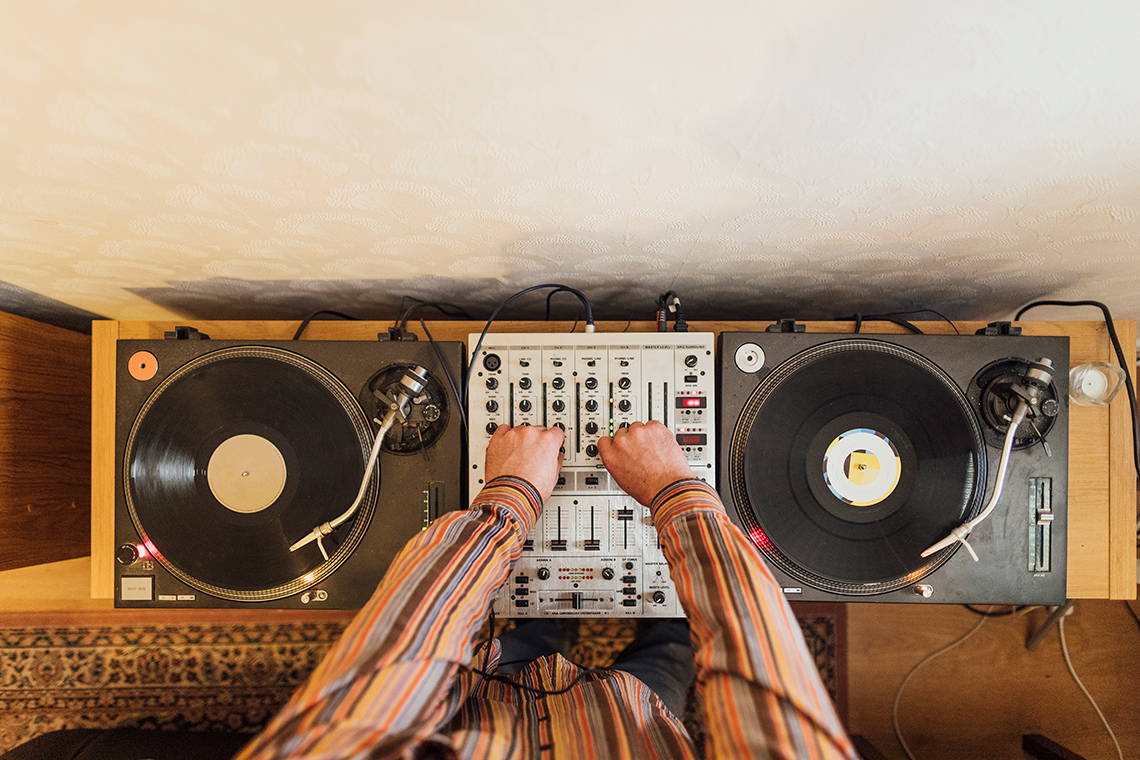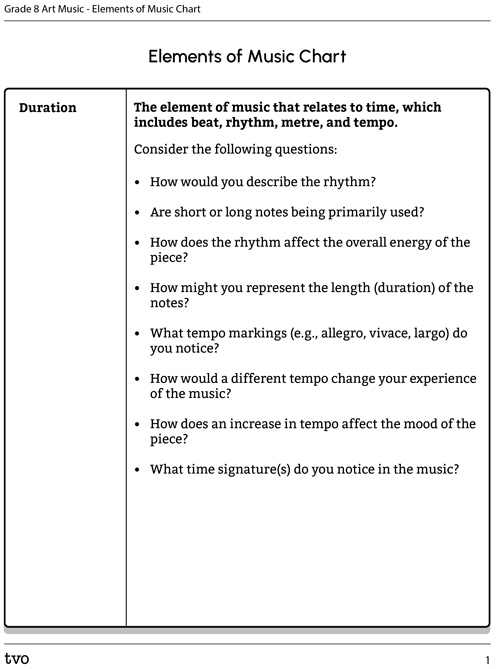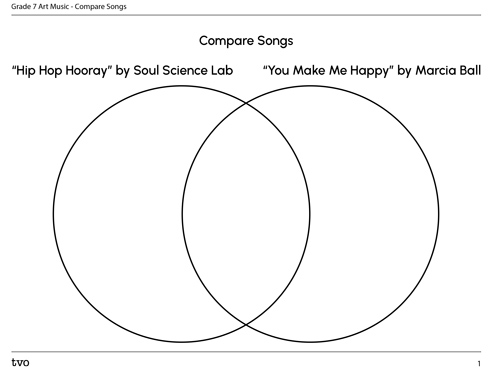Minds On
Today’s vocabulary
Press the following tabs to access definitions of concepts relevant for this learning activity.
Let’s get started!
The roots and the fruits
Examine the following quote by American Blues musician Willie Dixon:
“The Blues are the roots and the other musics are the fruits. It’s better keeping the roots alive, because it means better fruits from now on. The Blues are the roots of all American music. As long as American music survives, so will the Blues.”
Pause and Reflect
Pause and reflect
What do you think Willie Dixon meant by these words?
Record your ideas on paper, digitally, or as an audio recording.
Press ‘Answer’ to access a sample response to this question.
Willie Dixon is using the tree as a metaphor to describe how the Blues have influenced other music genres, just as the roots of a tree support the fruit to grow.

Explore the following clip of “Boogie Chillen” by John Lee Hooker.
In “Boogie Chillen”, John Lee Hooker plays an electric guitar and alternates between verses that are spoken and sung.
In this clip, he plays a single chord and a rhythm that repeats on the guitar. John Lee Hooker uses spoken word to tell a story about walking along Hastings Street in New York City, and entering a club where folks are dancing and “having a ball.”
Student Success
Think-Pair-Share
Consider the lyrics and the instruments used in the song. If possible, share your ideas with a partner.
- How does the rhythm affect the overall energy of the piece?
- Does this song remind you of other songs you know?
- How are they similar and different?
When I first come to town people, I was walkin’ down Hastings Street
I heard everybody talkin’ about, Henry’s Swing Club
I decided I’d drop in there that night, and when I got there
Note to teachers: See your teacher guide for collaboration tools, ideas and suggestions.
Action
Get ready, get set…
The Blues

Teacher A: The Blues is a musical genre that was created by African Americans in the southern United States and continues to influence music today. The music grew out of African oral traditions, call and response, spirituals, and rural work songs. Teacher B: The “blues” refer to struggles or hardships that were experienced by African Americans who were marginalized and economically disadvantaged. Creating and sharing music together provided communities with a space to share stories, express emotions, connect with each other, and offer support to overcome difficulties. Teacher A: The lyrics and the music of the Blues express powerful emotions about grief, loss, resistance, and pride.
How are the elements of music used in the Blues?
Explore the following facts about the Blues. Identify which element of music is being described.
You can refer to the Elements of Music Chart for further consideration of how the elements are described in Blues.
Element one
Western music is organized around keys. Within every key, there are notes that repeat. The key will change depending on the scale that the song is using. A major or minor scale has seven notes. The eighth note is the same letter name as the starting note.
For example, if the song is played in the key of C, the notes will be those found in the C major scale. In the key of C, the notes are C, D, E, F, G, A, B. The next note is C, and the pattern of notes repeats.
The Blues scale is a specific pattern of six notes that include flats, sharps, and natural notes. The seventh note is same letter name as the starting note, and the pattern of notes repeats. When notes are played in the minor scale, the notes create a sound that is more solemn and sad.
The Blues scale takes the notes from the minor scale and adds one more note to it, called the Blues note. The sound of the Blues note clashes a bit with the other notes, which is characteristic of Blues music.
Select the correct answer, then press ‘Check Answer’ to see how you did.
Here is an example the Blues scale in C minor.

There is a five line staff with a treble clef. There are six whole notes that represent the Blues scale in C minor. The notes ascend in the following order: C, Eflat, F, Gflat, Gsharp, Bflat, C.
Access this video in which the notes of the Blues scale in C minor are played on a saxophone.
Element two
Blues music uses a syncopated rhythm. Syncopation is when notes are placed “off the beat”. Here is an example of a syncopated rhythm:

There is a five-line staff with a treble clef and 4/4 time signature. There is a pattern of “off beats” that go: eighth note rest, eighth note, eighth note rest, eighth note, eighth note rest, eighth note. Underneath the rhythm are the words to count out the off beats: “one-and, two-and, three-and, four, and”
Examine this video titled “A Guide to Rhythmic Reading”, in which there are five notes with the rhythmic words displayed beneath them. They are: ti, ta, ti, ta, ta.
The first and third notes are eighth notes and the second, fourth and fifth notes are quarter notes. The four beats are represented above the notes with papayas. The notes are played by instruments.
Element three
Blues music uses dissonance which is a combination of two or more notes that sound like they clash. However, in the Blues, the unexpected sound of two notes that “don’t go together” can sound correct and natural. Dissonance can also create excitement because the tension needs to be resolved or released.
Element four
Blues music often follows a musical form called the 12-bar blues. A bar is a section of music that contains a certain number of beats. Blues music is written in a 12-bar repeating structure, where each bar has a specific harmony or chord. The 12 bars become a background to the song and are repeated, using a specific chord progression.
Here are two images that demonstrate this chord progression in the 12-bar Blues.

In this chart, each slash is a beat, each box is a measure, and each Roman numeral is a chord (I, II, IV, V). A musician would start by playing the 'I' chord for 16 beats, then move on to the 'IV' chord for 8 beats, and so on.
Visual of 12-bar blues.
There are twelve boxes representing the 12 bars or measures. They are organized in three rows with four boxes in each row. There are Roman numerals to indicate when to play the I, IV, V chords.
The chord progression goes like this:
I, I, I, I,
IV, IV, I, I,
V, IV, I, I
Underneath the Roman numeral is four slashes. Each slash is one beat.
The 12-bar blues is played in 4/4 time. There are four beats in every measure, and 16 beats in 4 measures.

Twelve boxes of music that represent bars, with different tiles that represent chord structure. The first four bars are the C chord, the next two bars are the F chord, the next two bars are the C chord, the next bar is the G chord, the next bar is the F chord, and last two bars are the C chord.
Examine the following Blues song called “You Make Me Happy” by Marcia Ball.
You make me happy – Marcia Ball
Use the checklist to identify the elements of music that are used in the song.
Elements of music
Hip Hop
Now that we have explored the roots, let’s explore the fruits (a music genre influenced by the Blues).
Hip Hop is a musical genre that was created by urban youth in Black and Latino communities in New York City, USA. Hip Hop has become one of the most popular and influential artistic, social, and cultural movements.
Hip Hop is more than music; it is a culture. It allows artists to express themselves, advocate for social change and empower those around them.
There are Four Core Elements of Hip Hop. They are DJing, MCing, Graffiti, and Breakdancing. DJs use a record player as an instrument to make a beat, play samples of other songs, and create effects, such as scratching.
Hip Hop lyrics are usually spoken, rather than sung. Rapping refers to poetic verses that are rhythmic and fast. The lyrics combine rhyme and rhythm and are layered over a pre-recorded beat or musical accompaniment.

How are the elements of music used in hip hop?
Read the following facts about Hip Hop. Identify which element of music is being described.
You can refer to the Elements of Music Chart for further consideration of how the elements are described in Hip Hop.
Press the following tabs to access more information about the elements of music in Hip Hop.
Hip Hop music is a very rhythmic type of music. Rappers and beat-boxers express themselves using fast rhythms. Background tracks are used and often include different drumbeats (called breakbeats).
Hip Hop sometimes includes a distinct melody in the background that repeats throughout the song. There is little singing in Hip Hop music. Rapping is a lyrical artform that is a distinctive feature in Hip Hop. Rap is rhythmic speech that is performed over pre-recorded beat or musical accompaniment.
Let’s examine a Hip-Hop instrumental track and pay attention to the drumbeat used, as well as the background melody.
In this clip, there is a simple piano melody that repeats. Layered on top of the piano melody is a drumbeat that also repeats.
Check out this audio clip that would help you understand pitch more.
"Behind Barz" - Anabolic Beats
Hip Hop music uses the DJ turntable as the main instrument. A DJ uses the turntable to play multiple records at once and alter the music in different ways.For example, a “mashup” is created by blending two or more pre-recorded songs together. Sounds can also be looped and repeated. Hip Hop music rarely uses live instruments, as the rapping and the lyrics are the focus.

In this image, the perspective is from a birds-eye view. There are two record players. In between the two record players is a DJ mixer, which includes knobs and switches. The image shows the arms of a DJ who is manipulating the mixer on the turntable.
Hip Hop uses special sound effects such as scratching. This is when the DJ maneuvers the record back and forth to create a scratching sound. Sometimes Hip Hop has other sound effects, too!
Examine this example of scratching and notice how the technique of scratching causes the music to repeat as the record is maneuvered back and forth on the turntable.
Access this audio clip recording of scratching.
Scratching
Go!
Compare and contrast
Let’s explore how the Blues and Hip Hop are related.
Using the elements of music, compare and contrast the following Hip Hop song and Blues song, or use a Hip Hop and Blues song of your choice.
Press the following tabs to access definitions of the elements of music.
The element of music that relates to time, which includes beat, rhythm, metre, and tempo.
The element of music that relates to the highness or lowness of a tone.
The element of music that relates to volume.
The element of music that relates to the quality of a sound (e.g., sound of a doorbell versus a laugh, a trumpet versus a clarinet, or two people speaking).
The element of music that relates to the layers of sounds within music.
The element of music that relates to the way musical pieces are organized.
This song is called “Hip Hop Hooray” by Soul Science Lab. As you examine the song, reflect on what elements of music stand out to you and how the elements are used in the song.
Access this audio clip entitled Hip Hip Hooray to learn more about elements of music.
“Hip Hop Hooray” by Soul Science Lab
Explore this audio clip entitled “You Make Me Happy” by Marcia Ball. As you examine the song, reflect on what elements of music stand out to you and how the elements are used.
You make me happy – Marcia Ball
Use the Venn Diagram, or another method of your choice, to compare how the elements of music are used in both songs.
Complete the Compare Songs in your notebook or using the following fillable and printable document. If you would like, you can use speech-to-text or audio recording tools to record your thoughts.
Consolidation
Putting it all together

Portfolio
Review your learning
Use the following questions to reflect on your learning. Record your response digitally, orally, or in print. Consider adding your response to your portfolio.
- What are some connections between Hip Hop and the Blues?
- What are the main differences? What are the main similarities?
- How does understanding the “roots” of music help someone to appreciate the “fruits”?
If possible, share your ideas with a partner.
Reflection
As you read the following descriptions, select the one that best describes your current understanding of the learning in this activity. Press the corresponding button once you have made your choice.
I feel…
Now, expand on your ideas by recording your thoughts using a voice recorder, speech-to-text, or writing tool.
When you review your notes on this learning activity later, reflect on whether you would select a different description based on your further review of the material in this learning activity.

